Hopewell Furnace showcases an early American landscape of industrial operations from 1771-1883, Hopewell and other iron plantations laid the foundation for the transformation of the United States into an industrial giant for the time. The park's 848 acres and historic structures illustrate the business, technology and lifestyle of our growing nation.
Hopewell Furnace Village
A community grew around the furnace, it yielded iron and a way of life.
Hopewell Furnace's Boarding House
Hopewell Furnace's Boarding House housed single men or those living away from their families, who came to work at the furnace.
Blacksmith Shop & Cast House
The Cast House was the industrial center of the ironworks. It is were iron ore was smelted into iron metal and products. The smaller blacksmith shop formed iron metal into all kinds of necessary tools and goods used in everyday life.
Hopewell Stove
The most notable manufactured product Hopewell Furnace made was its stoves. They were produced by the thousands at Hopewell and other like furnaces in the early 19th century and were transported for sale by horse and wagon.
Charcoal Pile
Charcoal was the fuel used to fire Hopewell Furnace and other furnaces of its age. Thousands of bushles of charcoal were made from hardwood trees on the furnace lands and entered into the furnace to keep it "in blast."




